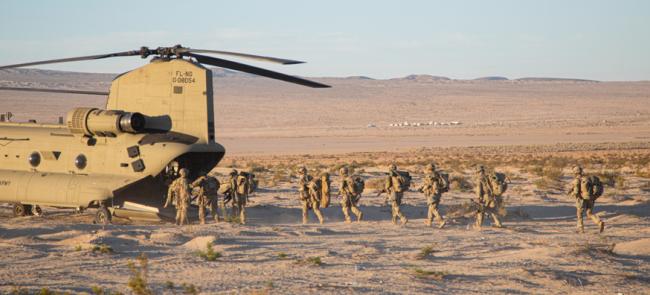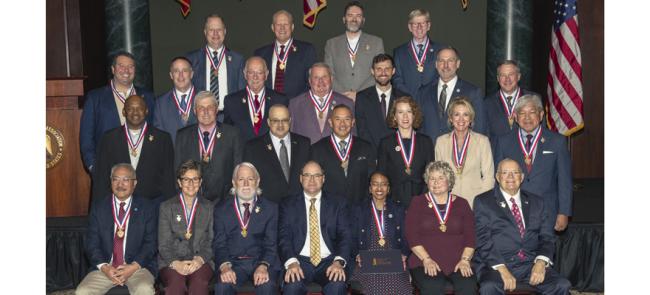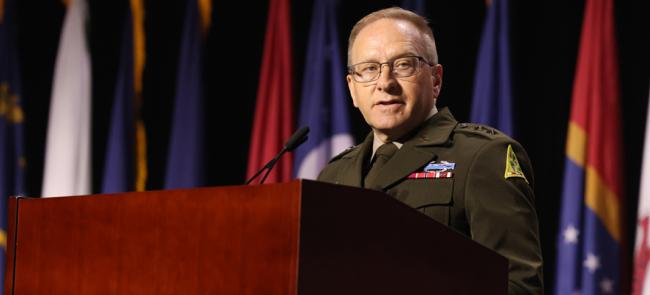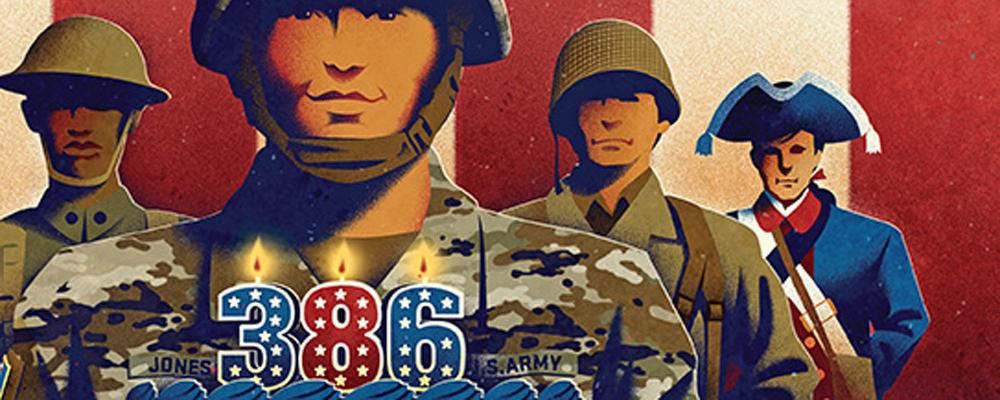
Two Birthdays
To those who know and love the National Guard, Dec. 13 is considered the birthday of America’s oldest military organization.
The 386th birthday will be commemorated with the usual kind words and the cutting of cake, perhaps a little champagne on December’s second Tuesday. It will celebrate the order by the Massachusetts Bay Colony’s Great and General Court, then the colony’s legislature, to form three militia regiments in the Boston region in 1636.
Hey, it’s our tradition.
The Guard’s other birthday, however, will probably go unnoticed, as usual, 39 days later.
The other birthday?
The enactment of the Militia Act of 1903 that gave the militias in the then-45 existing states a unified federal status, including funding, for the first time. The 57th Congress enacted Public Law 57-33 on Jan. 21, 1903. That action was the birth of the modern Guard as we know it today. As a result, next Jan. 21 will be the 120th birthday of the “new” National Guard.
First things first. Let us address some confusion surrounding the original birth. It has to do with the legal action and mustering of troops.
The General Court approved the order to create North, South and East Regiments from militia units in 14 towns, according to a translation of the original archaic English document. That action occurred in Boston, the colony’s capital, perhaps on the site now occupied by the Old State House.
The act was significant because it was the first time to anyone’s knowledge that village militia, which were considered essential for homeland defense and maintaining law and order, were formed into regiments in the New World. No one, however, apparently captured that December 1636 moment on canvas or in any other manner.
It’s the Guard’s first training assembly that actually gets the lion’s share of attention thanks to a 1984 painting, The First Muster, by military artist Don Troiani. It is part of the National Guard Heritage Series.
The painting depicts men in 17th century military attire training with their muskets on the drill field in Salem, about 20 miles outside of Boston, sometime during the first few months of 1637. Other men holding long pikes stand in the background. The activity even attracts a curious feline.
Militia units in that region — from Salem, Saugus, Ipswich and Newbury — formed up for the first time as the East Regiment, commanded by Col. John Endecot, to prepare to fight the troublesome Pequot Indians.
No one knows the precise date, says Guard historian Leonid Kondratiuk, who recommended to the chief of the National Guard Bureau, Lt. Gen. Herbert Temple Jr., that Dec. 13, 1636, be declared the Guard’s birthday. Nor does anyone know when the North and South Regiments held their first musters, he adds.
Why Salem? “The Great and General Court bought this land for a drill field,” explained East Regiment re-enactor Paul Kenworthy a dozen years ago. “The East Regiment included companies from the surrounding towns in Essex County. That’s why the regiment drilled on that very ground, before it was called a common.”
“Salem makes sense as a muster point because it was home of the colonel, John Endecot, who commanded the first militia company in the colony, in Salem, in 1629,” Kondratiuk explained.
The three regiments continue to serve today in the Massachusetts Army Guard, which makes them the oldest units in the U.S. military. Other states and Puerto Rico claim an even earlier militia heritage, but none of their current force structure has continuous lineage to those early units.
State militias were, by and large, provincial in nature and independent of any federal control for some 267 years. They adhered to the rules and the standards imposed by their states. And those varied considerably. Guard and militia men and units in northern states during the Civil War and those anxious to get a piece of the Spanish-American War had to serve as federal “volunteers.”
Birthday: A day or commemorating the origin, founding or beginning of something. — Webster's Unabridged Dictionary
THE MILITIA ACT OF 1903 established some nationwide rules and standards for citizen-soldiers when the Guard was 267 years old.
It has also been called the Efficiency in Militia Act of 1903, but it remains widely known as the Dick Act after Charles Dick, a Spanish-American War veteran, an Ohio Guard major general and the NGAUS president. Dick championed the legislation in the House of Representatives, where he chaired the Militia Affairs Committee.
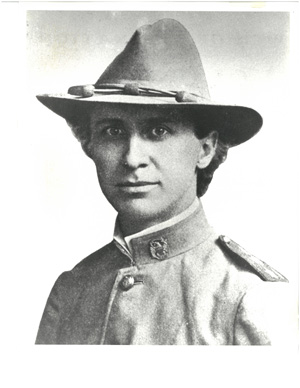
The new law included $2 million for Guard units to modernize equipment and permitted states to use federal funds to pay for Guard summer encampments. The War Department, the forerunner to the Defense Department, would also fund the attendance of Guard officers at Army schools.
In return, the federal government gained greater control over the Guard. States were required to carry out a uniform schedule of regular drills and annual summer camps. And they would have to organize and train their units in accordance with Army standards or risk losing federal recognition and funding.
Finally, the president was empowered to call up the Guard for as long as nine months to repel invasion, suppress rebellion or enforce federal laws. Guardsmen had to answer a presidential call or face court-martial.
“It is hard to overstate the significance of the Dick Act,” wrote historian Michael Doubler, who called it “benchmark legislation that repealed the Militia Act of 1792 and converted the volunteer militia into the National Guard. The days of the ill-defined relationship between the federal government and the militia were gone.”
More benchmarks would follow — Militia and National Defense Acts and a unanimous 1990 Supreme Court decision that prevented governors from blocking overseas deployments for training were necessary for the Guard to train and fight for America in foreign lands.
But the die was cast in 1903.
Still more laws and events have defined how the Guard has grown up over the past century.
AGE 280 — World War I
Before becoming a legendary World War II general, Douglas MacArthur helped pave the Guard’s way into global warfare during World War I on the strength of the 1916 National Defense Act.
MacArthur proposed to Secretary of War Newton Baker that the entire Guard be mobilized for duty in France to buy the Army time to build up.
The General Staff opposed the idea, but MacArthur, a major at the time, persuaded Baker who then influenced President Woodrow Wilson to deploy the Guard because it was active in every state, and it “could be gotten ready for oversees service in a fraction of the time it would take to train new recruits,” wrote historian Arthur Herman.
MacArthur also conceived of creating the 42nd “Rainbow” Division from surplus Guard units across the country. He went to France as the 42nd’s chief of staff and was the division commander when the fighting stopped in November 1918. The Guard became heavily engaged in the Second World War 23 years later and has been involved in every American war since then.
AGE 311 — A Second Guard
The Guard became distinct Army and Air National Guards in 1947 with the creation of DoD, originally called the National Military Establishment, by the National Security Act. That resulted in the establishment of the U.S. Air Force as a separate branch of the U.S. military and, concurrently, the birth of the Air Guard.
AGE 320 — Women Join
Women stepped up for Guard service beginning in 1956, just two days after Congress enacted legislation allowing them to serve as officers in the medical field.
Capt. Norma Parsons led the way when she was sworn in as a nurse with the New York Air Guard’s 106th Tactical Hospital. Second Lt. Sylvia Marie St. Charles Law became the first Army Guard female early in 1957 upon joining Alabama’s 109th Evacuation Hospital.
Sixty-five years later, 86,406 women are military police and pilots and in virtually every career field. They make up nearly 20% of the force, the National Guard Bureau reported in late October. The Army Guard is almost 20% female and the Air Guard is nearly 22%.
AGE 357 — State Partnerships
It didn’t take long for the Guard’s unique DoD-sanctioned program promoting international goodwill to progress from a walk to a run after taking its first step in 1993 as a spinoff from the 1992 Joint Contact Team Program. The world apparently liked the concept of stimulating “global security through U.S. cooperation with other countries,” as Reserve + National Guard Magazine recently put it.
Eleven eastern European countries, formerly part of the old Soviet Union, climbed aboard the first year and two more followed in 1994. Most were interested in learning about Western ways of defense and joining NATO. SPP will observe its 30th birthday next year and, as of last month, numbered 87 partnerships with the Guard in all 54 states, territories and the District of Columbia.
AGE 365 — War on Terror
The afterburners that Air Guard fighter pilots hit on 9/11 immediately after terrorists struck the World Trade Center in New York City and the Pentagon outside Washington, D.C., in 2001, abruptly signaled the new way that the Guard, and the entire defense establishment, did business. Homeland defense assumed a new urgency, and the Guard has provided much of the muscle during the two decades since.
AGE 375 — Joint Chiefs
Twenty-nine years after Lt. Gen. LaVern Weber became NGB’s first three-star chief, Gen. Craig McKinley was the first to pin on four stars in 2008. A bigger moment occurred on the final day of 2011, when President Barack Obama signed the fiscal 2012 National Defense Authorization Act making the NGB chief a member of the Joint Chiefs of Staff.
McKinley stepped up to that position in the face of some determined opposition. Every member of the Joint Chiefs had told the Senate Armed Services Committee the Guard didn’t need a seat at the table during a 2011 hearing on the subject. But McKinley made it clear that the Guard deserved and needed to be elevated to that level because of its nonstop foreign and homeland-security operational tempo.
Many on the SASC agreed, and the day was won. Nearly 12 years later, Gen. Daniel R. Hokanson is the fourth NGB chief to sit as an equal with the other Joint Chiefs.
The Guard’s upcoming 386th birthday may not create much excitement because it’s one of those ’tweener annual observances — somewhere between those ending in five and those ending in zero. But the 390th is just four years away. And the big 400, the quatercentenary, is not so far off as it seems.
Based on all that has happened so far, it is safe to assume that the Guard will have much to celebrate when those birthdays come around.
Bob Haskell is a retired Maine Army National Guard master sergeant and a freelance journalist in Falmouth, Mass. He may be contacted via [email protected].

